HISTORY 135F
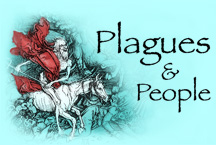
Infectious and
Epidemic Disease in History
Department of History
University of California, Irvine
Instructor: Dr. Barbara J. Becker
HISTORY 135F

Infectious and
Epidemic Disease in History
Department of History
University of California, Irvine
Instructor: Dr. Barbara J. Becker
we shall be acting on equal terms with God. --William Harvey, 20 May 1647 |
|
Samuel Pepys (1633 -1703)
|
|
|
|
born |
|
|
witnessed execution of King Charles I |
|
|
attended Magdalene College, Cambridge |
|
|
entered public service |
|
|
married Elizabeth Marchant de Saint-Michel, age 15, penniless daughter of a French Huguenot refugee |
|
|
was "cut for the stone" (lithotomy, removal of bladder stones) |
|
|
death of Oliver Cromwell |
|
|
appointed clerk to George Downing, teller in the Exchequer (salary, £50/yr) |
|
|
began his diary
|
|
|
took on post of Secretary to his cousin, Admiral Edward Montagu |
|
|
sailed with fleet that brought back Charles II from exile |
|
|
appointed Clerk of the Acts to the Navy Board (salary, £350/yr);
held post until 1673
given official residence on Seething Lane |
|
|
Second Dutch War |
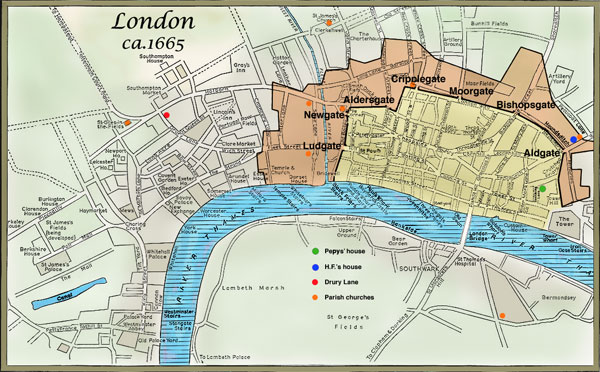
Map of London, ca. 1665
The map above shows the boundaries of:
the seven principal gates in the City Wall
locations of several parish churches mentioned in Daniel Defoe's Journal of the Plague Year (orange dots):
|
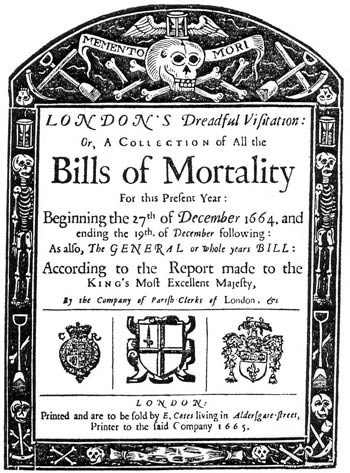 |
|
|
Modern explanations for old disease names |
|
| Childbed--death of mother from infection following childbirth; puerperal fever | |
| Chrisomes--death of infants in the first month of life | |
| Consumption--tuberculosis | |
| Dropsie--abnormal swelling of the body, or part of the body due to build up of clear, watery fluid | |
| Flox--hemorrhagic smallpox | |
| Flux--dysentery | |
| Gowt--gout; painful inflammation caused by a build up of uric acid in the tissues | |
| Head-mould-shot--infant whose skull bones are forced to overlap one another in a difficult birth | |
| Imposthume--abscess | |
| Kingsevil--scrofula; tuberculosis of the neck | |
| Livergrown--enlarged liver; possibly rickets | |
| Meagrome--severe headache | |
| Purples--rash due to spontaneous bleeding in to the skin; in newborns, may be due to insufficient vitamin K | |
| Quinsy--accute inflammation of the tonsils | |
| Rising of the lights--illness affecting the lungs ("lights" = lungs) | |
| Spotted fever--meningitis or typhus | |
| Stone--gall-stones | |
| Strangury--painful and difficult urination | |
| Surfeit--vomiting from over eating or gluttony | |
| Teeth--death of a teething infant | |
| Thrush--white spots and ulcers on the tongue and throat caused by a parasitic fungus | |
| Tissick--cough; phtisis; tuberculosis |
______
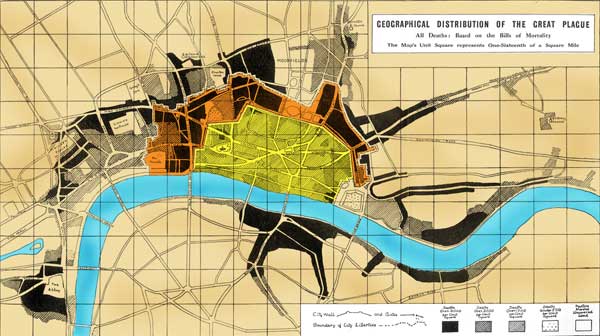
Areas in and around The City (yellow area) and Liberties (orange area) of London that were hardest hit by the plague are indicated in black (over 3,000 deaths per unit square); dark gray areas -- over 2,000 deaths/unit; gray areas -- over 1,000/unit; speckled areas -- under 500 deaths/unit. Unshaded areas are pasture, marshes or other uncovered land. |
Witnessing the Plague Year: 1665-1666 |
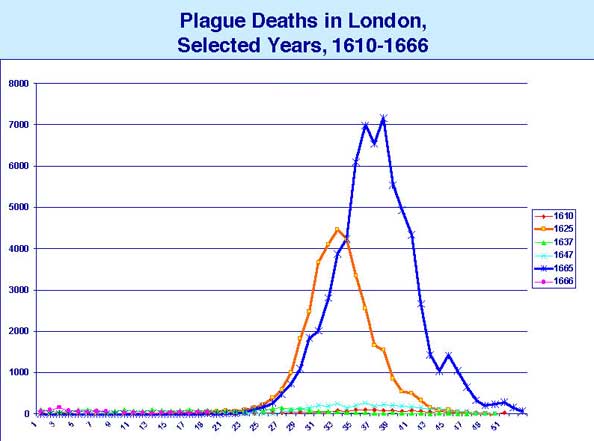
Deaths as recorded each week in Bills of Mortality during plagues of 1610, 1625, 1637, 1647, and 1665-6.
______
Daniel Defoe's Journal of the Plague Year |

Daniel Defoe (1660-1731) |
|
|
born Daniel Foe (formally changed his name to "Defoe" in the 1690s)
son of a butcher from Stoke-Newington |
|
|
married Mary Tuffley |
|
|
wrote a satirical political pamphlet |
|
|
arrested |
|
|
published periodical A Review of the Affairs of France
and of All Europe, resembled modern newspapers |
|
|
edited series of other periodicals |
|
|
published Robinson Crusoe |
|
|
published Moll Flanders
Journal of the Plague Year |
|
|
died |
Map showing principal locations in the greater London area that are mentioned in Journal of the Plague Year |
|
How does H.F.'s journal compare with that of Samuel Pepys? What is required to make historical fiction truly convincing? What resources are most useful? What are the risks and benefits of relying on eyewitness accounts? |
 |
| Go to: |
|
|